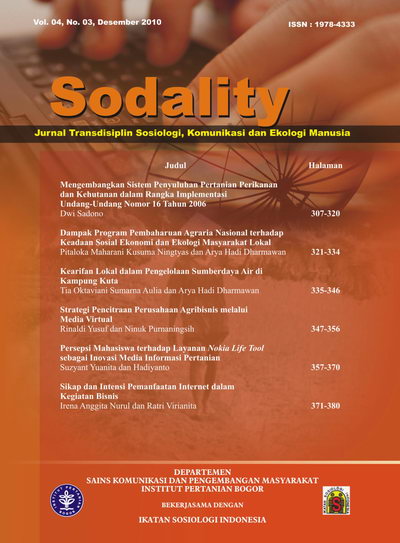DAMPAK PROGRAM PEMBAHARUAN AGRARIA NASIONAL (PPAN) TERHADAP KEADAAN SOSIAL EKONOMI DAN EKOLOGI MASYARAKAT LOKAL
Abstract
The objectives of this research are: (1) to compare the social-economic condition of communities before and after the National Agrarian Reform Program (PPAN); (2) to know the alteration of land placement (3) to explore the differences of perception from local communities about PPAN. This research was using qualitative and quantitative method. The qualitative method was supported by in-depth interview for collecting data. In the other hand, quessionaire used to be a research instrument to support quantitative method. There were 60 respondents who got PPAN program in this research which selected by purposive sampling technique.
Published
2010-12-11
How to Cite
Maharani Kusuma NingtyasP., & Hadi DharmawanA. (2010). DAMPAK PROGRAM PEMBAHARUAN AGRARIA NASIONAL (PPAN) TERHADAP KEADAAN SOSIAL EKONOMI DAN EKOLOGI MASYARAKAT LOKAL. Sodality: Jurnal Sosiologi Pedesaan, 4(3). https://doi.org/10.22500/sodality.v4i3.5840
Section
Articles
Authors who publish with this journal agree to the following terms:
- Authors retain copyright and grant the journal right of first publication with the work simultaneously licensed under a

This work is licensed under a Creative Commons Attribution 4.0 International License. that allows others to share the work with an acknowledgement of the work's authorship and initial publication in this journal. - Authors are able to enter into separate, additional contractual arrangements for the non-exclusive distribution of the journal's published version of the work (e.g., post it to an institutional repository or publish it in a book), with an acknowledgement of its initial publication in this journal.
- Authors are permitted and encouraged to post their work online (e.g., in institutional repositories or on their website) prior to and during the submission process, as it can lead to productive exchanges, as well as earlier and greater citation of published work (See The Effect of Open Access).





.png)









